Project Description
.
Interview with
EINAR SELVIK
from
WARDRUNA
(November 2020)
Interviewer – Amy Smith
.

Wardruna // Photo credit – Kim Öhrling
.
Norwegian composer and musician, Einar Selvik, is the creative head behind Wardruna, a project focusing on musical interpretations of different Old Norse and Nordic traditions. Thanks to extensive research and use of a wide range of old Nordic instruments and lyrics placed in a contemporary soundscape, Einar Selvik has moved musical genre boundaries as well as given a new voice to the thoughts and tools of the past.
Wardruna has gained worldwide recognition for its innovative musical expression, and Einar Selvik has even provided music for the popular TV-series Vikings and has recently been revealed as the composer writing the game’s original songs for Assassin’s Creed Valhalla, alongside the game’s composers Sarah Schachner and Jesper Kyd.
He took some time to catch up with AMNplify to discuss his contribution to the growing understanding of Norse Culture and the various projects he has been involved in, including Wardruna’s fifth, forthcoming album, Kvitravn, which is due for release January 22, 2021.
.
.
This has been a bit of a weird year. It has certainly impacted all of us in many different ways. I know that, for you, the release date for Kvitravn, unfortunately had to be pushed back. How have you been coping?
Pushing back the release was of course very disappointing. An album release, one thing is the studio work and all the planning that goes into it, but also all the other things that revolve around an album release. It’s quite a massive project that takes a long time to plan everything, the live performances and so on. So, that was very disappointing. I guess, in this kind of setting you just need to stay constructive and unfortunately it means that at all times you need to have a plan A, B, C in many different things. For me, I’ve been fortunate in the sense that I’ve been, my calendar has been filled up with other studio work this period. I’ve been working a lot with the soundtrack for Assassins Creed: Valhalla. In a way that… if I have to say something positive about this, it allowed me to work on the finishing points of that, in a perhaps more healthy way, with less time pressure and other things that would have had to be done alongside the album release and stuff like that. So, all in all, it’s been an OK period. Strange times of course.
Speaking of Assassins Creed: Valhalla, can you talk me through that experience?
We are three composers working on a game. The two others, Sarah Schachner and Jesper Kyd, they are more working on the classical soundtrack, whereas I do more of the ‘in game’ songs. The focus has been on the Skaldic tradition. The oral/poetic tradition, this musical form, highlighting this tradition that sort of once at the heart of the Old Norse culture. So that is my task, creating the Skaldic songs and the soundscape that you experience inside the game whenever you’re in the longhouse or at markets, these are the songs that will be heard. And of course, the special quests and stuff like that. There are more fully produced versions, more in the soundscape familiar to people who listen to Wardruna. It’s a bit of both. I’ve been working with these really stripped down, acoustic things but also the fully produced stuff. It’s been a very enjoyable project to be a part of. It’s such a huge and ambitious project on all aspects. Not only on music but on many other levels as well.
I know that you’ve done work for TV as well. Can you talk me through some of those experiences, like do you have a preference for either format? What differences are there and how do they impact on songwriting?
Yeah, I would say that there is quite different format and different approach to it. Because you always have to relate every second on the screen. Here (The game) you can paint with broader strokes, in a way. I could think more in terms of traditional songwriting.
I’d like to learn more about your upcoming album Kvitravn. You are known for constantly trying out new things within your music. What new instruments/techniques/approaches did you use for this album?
I guess the creative concept is sorta the same that it’s always been. Whereas it’s the themes themselves, the idea behind the song that defines the instrumental needs and the sounds I use, where and when I record etc. But, of course it’s a continuation. I constantly evolve and learn new things and grow as a human as well a composer. So, I’m always trying out new things. Conceptually, I would say the thematics of the album is in the same landscape. It’s about our relation to nature, to each other and to something that is bigger than yourself. I would say the difference here is that I zoom more into details on this album. In terms of instruments, I think that I do introduce some new instruments. But they’re kind of in the same instrument family, it’s new versions on the same instruments, I would say. It’s in many ways in the same landscape.
.
.
Speaking of instruments…
Wardruna uses a lot of ancient instruments, things that don’t, well didn’t, exist anymore. You must have done extensive research in order to build your instruments as close as possible to the original ones, both in terms of materials used and sounds produced. This also means you often had to build them yourself, or find someone to build them for you. Can you tell me a little bit about your experience with discovering and creating these instruments?
Yeah! Of course! When I started out this project, 20 or so years ago, there weren’t really a lot of interest for them or information about them. Very few people built them, or at least some of them. On the other hand there are a few of these old instruments that are is actually living tradition of using. I guess, as you say, in the beginning there was a lot of researching, diving into music archaeology, visiting musicians, talking to instrument builders, because yeah, in some cases I had to build the instrument myself and for other instruments I had other people build them for me. A bit of both. So, a lot of trial and error I guess. I have to say I made quite a few shitty instruments along the way! It’s, of course, an interesting process and giving voice to these instruments. These days the interest for them and the amount of builders, that’s just exploded the last few years! So that’s great to see! I guess we’re a part of that growth as well.
How does If feel to be a part of being a part of generating that growing interest in and spreading more accurate representation of Norse culture?
It’s of course a great feeling! It’s part of why we are doing what we are doing. It’s not necessarily this romantic idea that everything was so much better back in the past. But more about highlighting and giving voice to certain things that we believe still resonates with people. Obviously it does. I think certain things are worth remembering from the past, sort of having a continuing tradition of using.
How do you balance staying authentic and then bringing a modern interpretation to the music?
For us, it’s never been a goal to try and recreate music from any specific time period. The instruments we use are from a range periods, from the Stone Age throughout the Bronze Age to the Viking/Medieval era within a modern soundscape. For me, it’s been important to do a lot of proper research, in terms of studying what we know and how we know it. I guess that part of the process is quite academic because I do find a value in standing on solid ground before I venture into the more creative processes. So for me, it’s not about copying the past, but rather learning from it and creating something new with it, highlighting mostly the things that I deem as relevant for the contemporary. I think that If you want to sow new seeds, it’s important to look more in front of you than behind, but of course it’s important to not forget the roots, they give direction. Yeah, so I guess it’s a balance between an academic approach and creative/intuitive work, but always starting with the academic side. Solid ground.
I guess it’s the same idea with your lyrics. These concepts are presented in abstract ways that encourages the listener to seek their own understanding. So, for those who are interested in exploring the themes of your songs in more detail, do you have any recommendations for sources that credibly present Norse mythology?
Yeah, the whole poetic corpus is, of course, the best place to start. Studying the primary sources is always a good thing. The Eddaic and Skaldic poetry are the most important written sources we have of these things. But also, our tradition from the old ways until Christianity came about. It wasn’t a grass roots movement, which means it came from the elite, it came from the top. This meant that people kept their way for such a long time, even almost up to our age! There are a lot of remains from the old ways. So, studying the folklore up until modern day is also useful information when studying these things. I find diving into the mythology is a very good place to start.
.
.
You sing lyrics in Old Norse, is that correct?
I guess my approach to language is of the playful sorts. I wouldn’t sing in contemporary Norwegian, it would be more like how my grandfather talked, in a way. An older version or older dialect of our contemporary language. But, I combine it with Old Norse, even Proto-Norse language. It varies.
Does it flow naturally, or do you sometimes look to the dictionary for words to find something that feels right?
Sometimes I have to do that, of course. Old Norse is not my native language anymore. Even though the modern language is based on Old Norse, so there are many words that are the same. I’ve been working with Old Norse material for many years now, so it’s something that my vocabulary and knowledge of language is growing all the time. But still, it’s definitely something that I both need to confer with experts and yeah, the dictionary.
We kind of touched on earlier that there seems to be an increased interest in Norse mythology. When you see these references in modern pop culture, do you find most are doing their homework? Can you tell when they haven’t?
I have to say that there is quite a bit of both (laughs). But that is also a natural thing. I guess, the Norse culture is very full of stereotypes and popular misconceptions, for several reasons. I guess the word ‘Viking’ itself is a little bit problematic because it’s very often been used to define a whole culture, when in reality, ‘Viking’ is a verb. It’s an ‘act’. It’s something you do not something you are. In most cases, it really defines only what a small amount of people did for a short amount of time. So, defining a whole culture based on that is simply wrong. Which is perhaps the biggest misconception. But yeah, in any case, popular culture’s use of Norse history, I would say balances between correct, authentic information but also plays on the contemporary notion of what that time is. I guess that’s only natural. In any case, I think these things are getting better and better. It seems that the knowledge of that time is becoming more and more increased and people, I would say, are more hungry for knowing the real stuff rather than just the popular notion of it.
In past interviews you’ve spoken about letting the instruments find their own voice. Obviously, that will look different for each instrument, but i’m wondering if there are any general strategies or techniques that assist with that process?
Yeah, well in the beginning I was very decided upon the fact that I didn’t want to hear music played on some of these instruments because I wanted to find it’s own voice and approach it more like a child rather than playing my own preconceptions of what it is supposed to sound like. I guess that was an important part of that process. Also, some of the instruments are quite limited in what you can and cannot do on them, that sort gives you are very good set of guidance in itself and puts is automatically into something you can call authentic or something that you can call pretty close to historically authentic representation. These limitations can be a good guide. But in any case, in terms of the musicology, I have to say, it’s a giant jigsaw and you have to have a broad overview of the different sources to be able to narrow it down. My advantage is that I not only have the academic, the knowledge of the sources, but I also have a practical perspective. I get to try out many of these hypotheses in real life. Sources will only take you this far, and then it comes down to logic of performance, of creativity, of musicology in way. It’s a fruitful combination.
It’s sounds like a very interesting, but time consuming process!
Yeah! I spent seven years creating the first album! A lot of that was about finding that balance and the recipe of how to work with these instruments.
.
.
I know that a lot of time goes into finding the right sounds and the right moods. How do you go about translating this in the live setting?
Well in some cases it’s a given, but I guess in a live setting you have to think a little bit different. Some songs, I do create different versions of them when we perform them live, simply because it’s a different format and you’re catering to different needs, to put it very simple. I guess that process is also a little bit trial and error. Things have been adjusted along the way and over the last ten years, since the first performance in 2009.
So, it’s a learning process that is never gonna stop. It’s just constant learning.
Yeah! As it should be.
You have had some opportunities to play in some pretty unique environments, are there any that particularly stand out for you personally?
Well, I kinda feel that the very first concert we did, in front of a 1500 year old Viking ship in a museum in Oslo, set the bar pretty high! I guess it made me realise, and I’m very thankful for that experience at such an early stage, how important surroundings are in terms of performance. It’s led us into being very strict about those sorts of things because it’s my experience that if you play in a setting or surrounding that somehow compliments the music itself, it becomes a positive synergy effect. So 2+2 becomes 5 in a way, so it increases the chances of making it even more powerful, both for the audience and for us performing. It amplifies it.
Have you ever found yourself in any creative ruts? What do you do when you can’t find inspiration?
Yeah, of course. I’m very conscious of not wanting to push it too far, like squeeze things into a shape that they don’t belong in, just because you need to get on with it in a sense. So, my process is quite patient. But on the other hand, I think the creative process is quite painful. It goes up and down and sometimes you have to move through these droughts. There’s this stereotypic idea that you’re sitting on a rock out in the Forrest and suddenly being struck by inspiration. That you have to sort of wait for these occasions to be creative. That’s not correct. It’s not a healthy way either. You have to work at it and move through these droughts actively. That’s my experience. Of course, there are many ways of approaching that. For me, my main muse to create is to walk. That’s very often when I get perspectives or hear the songs. That’s something I use actively.
Is there anything that I haven’t covered that you would like to talk about today?
I have to say that I really hope that we get the chance, that once the world goes back to some form of normality, that we get the chance to travel down under and do some concerts down there. That’s something that we’ve been working on for a bit of time now, so hopefully that is something that will come into reality soon!
.
.
Check out WARDRUNA below
Website – Facebook – Instagram – Twitter
.
.










